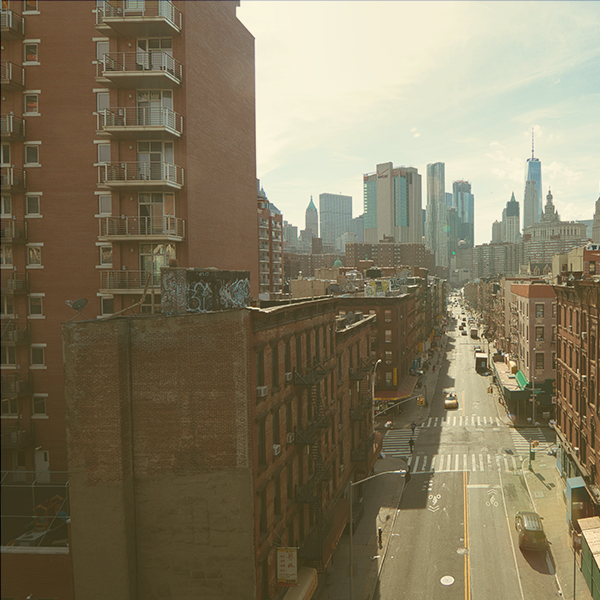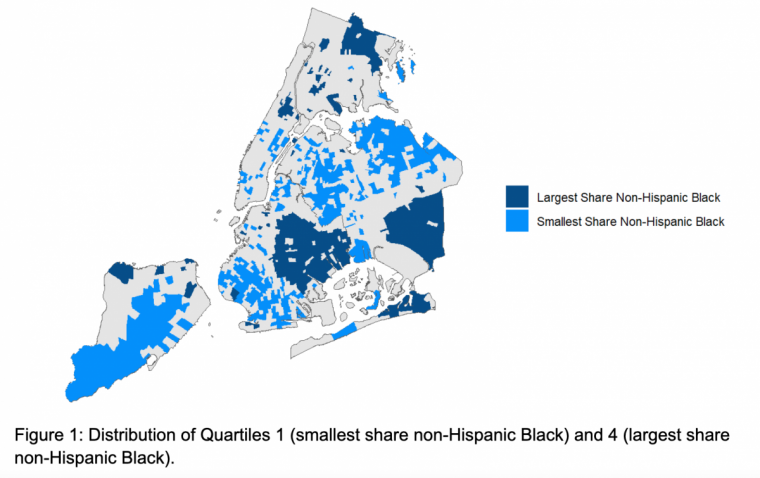
Racial Inequities in New York City’s Property Tax System

New York State's highest court is set to hear a case filed by Tax Equity Now New York, which alleges New York City's property tax system of unlawfully discriminating against New Yorkers of color and favoring wealthy, white residents. This notoriously complex system, which varies significantly from the rest of the country, often adversely impacts low-income residents of color. Our 2011 State of the City report serves as a primer, explaining how these property taxes are calculated and revealing the potential for ongoing inequity in the city’s tax system.
To understand whether and to what extent this inequity continues to be stitched in New York City’s tax system, we examined recent property tax data on New York City’s Class I properties (1-3 family homes) and how average effective tax rates correlate with neighborhood demographics. We found that even in recent years, homeowners who reside in predominantly non-Hispanic Black areas pay a larger effective tax rate than homeowners in areas with predominantly non-Hispanic white residents. We estimate that if all homeowners were subject to the citywide average effective tax rate during Fiscal Year 2018, homeowners in the neighborhoods with the largest share Black population would have paid about $17 million less in property taxes per year, and the quartile with the smallest share Black population would have paid $10 million more.
Areas with a Higher Shares of Black Residents Have a Larger Effective Property Tax Rate
Our analysis showed a significant correlation between the racial composition of neighborhoods and the average effective property tax rate of neighborhoods. Specifically, areas with a higher population of non-Hispanic Black residents faced higher effective assessment rates and tax rates compared to those with more non-Hispanic White residents (see Table 1). While correlation does not mean causation, the outcome of the property tax system is that effective property tax rates do correlate with neighborhood racial composition.

The Larger Effective Property Tax Rate Translates to Greater Property Tax Liability
To gain an understanding of how this disparity aggregates citywide, we grouped Census tracts into quartiles based on the share of the population that is non-Hispanic Black (with Quartile 1 having the lowest share non-Hispanic white and Quartile 4 having the largest share). We then found the average effective tax rate of each quartile and calculated the total fair market value of Class 1 properties from our sample in each quartile.

To understand each neighborhood quartile's total Class I property tax liability, we first used their average tax rates and applied them to the overall property values. Then, we checked what would happen if all neighborhoods were charged the same tax rate used citywide. With this approach, we found that the quartile of census tracts with the lowest share Black residents would have paid around $10 million more in total, while those with the highest share of Black residents would have paid around $17 million less under the citywide rate. It’s important to note that these differences in tax payments can add up year after year, affecting not just how much people pay in taxes, but also potentially influencing the future selling price of their homes.

To further understand the extent of the inequity, we found that if neighborhood quartile with the smallest share Black population was subject to the average effective tax rate of the quartile with the largest share Black population, it would pay around $100 million more, and, if the quartile with the largest share Black population was subject to the average effective tax rate of the quartile with the smallest share Black population, it would pay around $22 million less.
Conclusion
The results of this analysis suggest that Black homeowners pay a larger effective tax rate than homeowners of other races, particularly white homeowners. Our analysis paints a stark picture of the systemic inequities embedded within New York City's property tax system. Residents in neighborhoods with higher shares of Black residents are disproportionately burdened with higher effective property tax rates compared to their white counterparts. This disparity not only violates the principles of Equal Protection and Fair Housing laws but also contributes to deepening the divide in housing affordability, placing a heavier financial burden on Black households and potentially affecting the long-term value of their properties.
Notes on Methodology
For the analysis, the Furman Center used notices provided by the New York City Department of Finance of property valuation and assessment sent to taxpayers from Fiscal Year 2018 (the most recent set publicly available). There, we obtained the fair market value and the assessment value for residential buildings with three or fewer units and a fair market value of at least $50,000. We then obtained the property tax rates set by City Council and applied them to the assessed value to impute the taxes owed.
To evaluate the equity of property taxes, we used the imputed tax amount to calculate the effective tax rate. Technically, all properties of the same tax class are subject to the same nominal tax rate (e.g., in Fiscal Year 2018 all Tax Class 1 properties were subject to a 20.919 percent tax). However, the nominal tax rate is only applied to the assessed value and not the full fair market value. The effective tax rate, calculated by dividing the tax estimate by the fair market value, is essentially the nominal tax rate that would result in the same tax liability when applied to the full fair market value.
To identify potential racial disparities, we compared the average effective tax rate for each Census tract to the racial demographics of the Census tract using the 5-year American Community Survey ending in 2019. Ideally we would know the race of each homeowner to calculate the exact relationship between race and effective tax rate, but racial homeownership data is not publicly available. Instead, we use the racial makeup of the neighborhood as a proxy.


